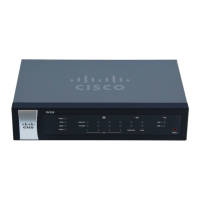Setup
Port Address Translation
Cisco RV320/RV325 Administration Guide 37
3
Port Address Translation
Port Address Translation (PAT) is an extension of Network Address Translation
(NAT) that permits multiple devices on a LAN to be mapped to a single public IP
address to conserve IP addresses.
PAT is similar to port forwarding except that an incoming packet with destination
port (external port) is translated to a packet different destination port (an internal
port). The Internet Service Provider (ISP) assigns a single IP address to the edge
device. When a computer logs on to the Internet, this device assigns the client a
port number that is appended to the internal IP address, giving the computer a
unique IP address.
If another computer logs on the Internet, this device assigns it the same public IP
address, but a different port number. Although both computers are sharing the
same public IP address, this device knows which computer to send its packets,
because the device uses the port numbers to assign the packets the unique
internal IP address of the computers.
To add or edit PAT:
STEP 1 To add a service, click Add in the Port Address Translation table.
To edit a service, select the row and click Edit. The fields are open for
modification.
If the web browser displays a warning about the pop-up window, allow the
blocked content.
STEP 2 Select the Service from the drop-down menu. You can have up to 30 services. (If a
service is not listed, you can modify the list by following the instructions in the
Adding or Editing a Service Name section.)
STEP 3 Enter the IP address or the name of the network device where the service resides.
STEP 4 Click Save.

